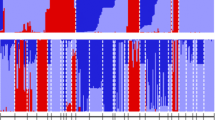Abstract
Removing redundant germplasm from collections is one of the options for genebanks to increase the efficiency of their genetic resource management. Molecular characterisation of germplasm is thereby becoming more and more important to verify suspected duplication. AFLPs were used to characterise 29 flax accessions of material derived from research activities (hereafter termed ’’breeder’s line”). Based on similar accession names, the breeder’s lines could be classified into three series (’M 25’, ’Ru’ and ’Rm’) that were expected to contain redundancies. In addition, 12 reference cultivars were analysed. A total number of 144 polymorphic bands (59.8%) were scored among the 164 individuals investigated. In general, relatively high levels of intra-accession variation were found, even for the cultivars examined. This finding was not in line with the low outcrossing rates reported for flax. A cluster analysis grouped the ’Ru’ and ’Rm’ series together, indicating their close genetic relationship. An analysis of molecular variance (AMOVA) showed a significant group effect (fibre/oil flax) only for ’M 25’, explaining 34% of the variation observed within this series. For the cultivars 40.5% of the variation was distributed among accessions within groups and all pairwise comparisons were significantly different, except for one case. Both for the series of breeder’s lines and the cultivars the major part of the variation was distributed among individuals within accessions. This component constituted 80.7% and 83.6% of the total variation for the ’Ru’ and ’Rm’ series, respectively. Pairwise comparisons of accessions were performed by AMOVA in order to identify redundant germplasm. Stepwise bulking of accessions until all remaining accessions were significantly different showed that the 29 accessions of breeder’s lines could be reduced to 14. Only a small negative effect of this bulking approach on the among-population component of variance was observed, showing a reduction of 2.6%. Results are discussed in relation to improving the efficiency of collection management.
Similar content being viewed by others
Author information
Authors and Affiliations
Additional information
Received: 25 June 2000 / Accepted: 27 October 2000
Rights and permissions
About this article
Cite this article
van Treuren, R., van Soest, L. & van Hintum, T. Marker-assisted rationalisation of genetic resource collections: a case study in flax using AFLPs. Theor Appl Genet 103, 144–152 (2001). https://doi.org/10.1007/s001220100537
Issue Date:
DOI: https://doi.org/10.1007/s001220100537




